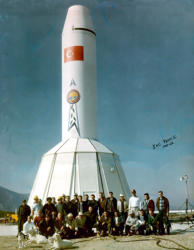HISTORY - Page 48
As to other missile vital statistics, the JUPITER was a single-stage, liquid-propelled, rocket-powered ballistic
missile, designed to carry a 1,600-pound payload to a maximum range of 1,500 nautical miles, with a 1,500-
meter circular probable error (CPE). It was composed of three major assemblies: the nose cone, the aft unit
with instrument group, and the thrust unit. Structural loads were divided between the missile skin and a
number of Z-ring stiffeners. The ablative heat-protected nose cone contained the warhead, fuzing and
arming device, and related power equipment. G&C was housed in the aft unit, with the exception of such
components as the swiveling actuators for the main rocket engine. Vernier engine spin rockets and jet
nozzles for spatial attitude control were also located in the aft unit. When the nose cone and aft unit were
joined, it became the missile body. The thrust unit was made up of a center unit containing the propellant
tanks and lines, the rocket engine, and the tail section. The tail section also contained cabling and
propulsion system accessories
63
.
Propulsion of the JUPITER was accomplished by an NAA rocket engine (NAA-150-200-S-3D) rated at 150,000
pounds of thrust. Fuels used were liquid oxygen (L0X) as the oxidizer and kerosene or RP-1 as the
propellant. The engine was mounted on gimbals which allowed a pitch or yaw movement up to plus or
minus seven degrees. This action was produced by an electro-hydraulic actuator system which received its
signals from the G&C system. Propellants were fed to the main engine by two turbine-operated pumps,
which operated on a gas produced in a LOX-RP-1 gas generator. The generator was fueled from the main
propellant tanks.
_____________________________







63. Standard Msl Characteristics, SM-78B JUPITER, released by auth Secy AF, 16 May 60; SACOP 1-58, 4 Mar 58, Hist Off files.



Jupiter SM-78 Weapon System
I&C Team 2, Çigli AB, Turkey 1961-1962 Chrysler Corporation Missile Division

HISTORY - Page 48
As to other missile vital statistics, the JUPITER was a
single-stage, liquid-propelled, rocket-powered ballistic
missile, designed to carry a 1,600-pound payload to a
maximum range of 1,500 nautical miles, with a 1,500-
meter circular probable error (CPE). It was composed
of three major assemblies: the nose cone, the aft unit
with instrument group, and the thrust unit. Structural
loads were divided between the missile skin and a
number of Z-ring stiffeners. The ablative heat-
protected nose cone contained the warhead, fuzing
and arming device, and related power equipment. G&C
was housed in the aft unit, with the exception of such
components as the swiveling actuators for the main
rocket engine. Vernier engine spin rockets and jet
nozzles for spatial attitude control were also located in
the aft unit. When the nose cone and aft unit were
joined, it became the missile body. The thrust unit was
made up of a center unit containing the propellant
tanks and lines, the rocket engine, and the tail
section. The tail section also contained cabling and
propulsion system accessories
63
.
Propulsion of the JUPITER was accomplished by an NAA
rocket engine (NAA-150-200-S-3D) rated at 150,000
pounds of thrust. Fuels used were liquid oxygen (L0X)
as the oxidizer and kerosene or RP-1 as the propellant.
The engine was mounted on gimbals which allowed a
pitch or yaw movement up to plus or minus seven
degrees. This action was produced by an electro-
hydraulic actuator system which received its signals
from the G&C system. Propellants were fed to the
main engine by two turbine-operated pumps, which
operated on a gas produced in a LOX-RP-1 gas
generator. The generator was fueled from the main
propellant tanks.
_____________________________
63. Standard Msl Characteristics, SM-78B JUPITER, released by auth Secy AF, 16 May 60; SACOP
1-58, 4 Mar 58, Hist Off files.





















